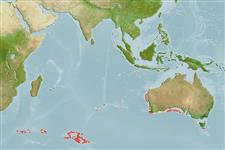Élasmobranches (requins et raies) (sharks and rays) >
Squaliformes (Sleeper and dogfish sharks) >
Centrophoridae (Gulper sharks)
Etymology: Centrophorus: centr[um] (L.), prickle or sharp point; phorus, from phoreus (Gr.), bearer or carrier, referring to grooved spines on dorsal fins (See ETYFish); westraliensis: -ensis, Latin suffix denoting place: Western Australia, only known area of occurrence (See ETYFish).
Environment: milieu / climate zone / depth range / distribution range
Écologie
marin bathydémersal; profondeur 616 - 750 m (Ref. 76933). Tropical
Eastern Indian Ocean: Western Australia.
Taille / Poids / Âge
Maturity: Lm ? range ? - ? cm
Max length : 90.9 cm TL (female)
Description synthétique
Clés d'identification | Morphologie | Morphométrie
This moderate-sized species has the following set of adult characters: length of pre-second dorsal 63.8-64.9% TL, 8.8-9.7 times dorsal-caudal space; length of pre-first dorsal 31.3-32.7% TL; interdorsal space 20.3-21.5% TL, 2.8-3.1 times dorsal-caudal space; dorsal-caudal space 6.7-7.3% TL, 4.4-4.9 in pectoral-pelvic space; long and moderately robust head, its length 23.2-24.7% TL, 3.1- 3.2 times mouth width, its width 11.7–12.8% TL, 5.1-5.5 in pre-second dorsal length; width at anterior of nostrils 7.1-7.6% TL; long snout, its preoral length 10.9-12.4% TL, 2.0-2.2 times head height at anterior of mouth, 1.4-1.6 times mouth width; horizontal preorbital length 7.0-7.8% TL; horizontal prenarial length 4.5-4.9% TL; moderately large mouth, its width 7.6–7.8% TL; large pectoral fin, its anterior margin 12.9-14.2% TL, 2.6-2.8 times base length; large caudal fin, its dorsal caudal margin 17.4-20.2% TL; 2.6-2.9 times dorsal-caudal space; moderately-sized first dorsal fin, its height 5.5-6.4% TL, with relatively robust spine, its base width 1.1-1.2% TL; dorsal fins of juveniles have a distinct blackish oblique blotch anteriorly and a white blotch on the upper posterior margin; in adults a less distinct dark blotch which is usually still apparent in fresh specimens and with white blotch restricted to a narrow white posterior margin which can be indistinct in larger preserved specimens; females and an immature male with upper teeth strongly oblique, similar in shape, but much smaller than lower teeth; 38/29.teeth count in holotype; adults with flank denticles flat, not overlapping, with scalloped edges; 112-117 (mean 115.3) total vertebral centra; 55-57 (55.8) monospondylous precaudal centra; 29-33 (31) diplospondylous precaudal centra; 85-88 (86.8) precaudal centra; 27-30 (28.5) diplospondylous caudal centra (Ref. 76933).
Life cycle and mating behavior
Maturité | Reproduction | Frai | Œufs | Fécondité | Larves
White, W.T., D.A. Ebert and L.J.V. Compagno, 2008. Description of two new species of gulper sharks, genus Centrophorus (Chondrichthyes: Squaliformes: Centrophoridae) from Australia. pp. 1-21. In P.R. Last, W.T. White and J.J. Pogonoski (eds). Descriptions of new Australian chondrichthyans. CSIRO Marine and Atmospheric Research Paper no. 22. 365 p. (Ref. 76933)
Statut dans la liste rouge de l'IUCN (Ref. 130435: Version 2024-2)
Menace pour l'homme
Harmless
Utilisations par l'homme
Outils
Articles particuliers
Télécharger en XML
Sources Internet
Estimates based on models
Preferred temperature (Ref.
123201): 1.7 - 8.2, mean 6.9 °C (based on 11 cells).
Phylogenetic diversity index (Ref.
82804): PD
50 = 0.5001 [Uniqueness, from 0.5 = low to 2.0 = high].
Bayesian length-weight: a=0.00245 (0.00116 - 0.00519), b=3.20 (3.02 - 3.38), in cm total length, based on LWR estimates for this (Sub)family-body shape (Ref.
93245).
Niveau trophique (Ref.
69278): 4.3 ±0.3 se; based on size and trophs of closest relatives
Résilience (Ref.
120179): Très faible, temps minimum de doublement de population supérieur à 14 ans (Preliminary K or Fecundity.).
Fishing Vulnerability (Ref.
59153): High vulnerability (56 of 100).
